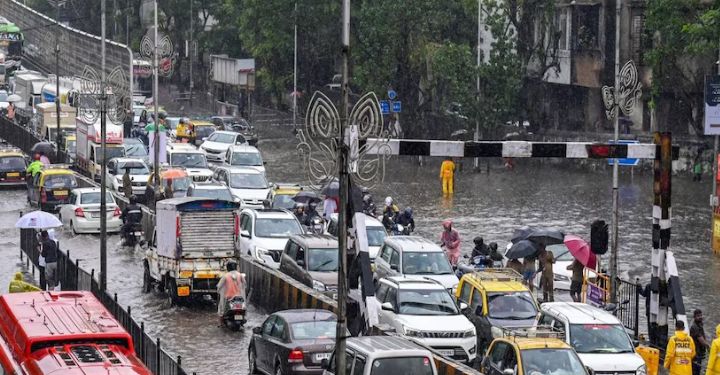
Mumbai has entered a state of high alert after the India Meteorological Department (IMD) issued a Red Alert warning for extremely heavy rainfall across multiple regions of the city and its suburban districts. This early burst of monsoon activity has not only shattered rainfall records but also tested the limits of the city’s already burdened infrastructure.
An Alarming Start to the Monsoon
The IMD confirmed the early onset of the southwest monsoon on May 26, several days ahead of its usual schedule. Within hours, torrential rain battered key zones, with South Mumbai’s Colaba recording nearly 440 mm of rainfall in a single day. This marked one of the heaviest spells for the region in over a century.
As the rain pounded relentlessly, local authorities scrambled to activate emergency protocols. The BMC initiated disaster response mechanisms, closing flood-prone underpasses and opening temporary shelters for stranded commuters. Meanwhile, schools and colleges were promptly shut down for the day.
Transport Disruptions Paralyze City Movement
Mumbai’s lifelines—the suburban train systems—faced major disruptions. Over 50 train services on the Central and Harbour lines were cancelled due to waterlogging on the tracks. Western Railways also reported halts between Churchgate and Dadar as floodwaters rose above safe operational levels.
Road traffic wasn’t spared either. Massive traffic snarls were reported on the Eastern and Western Express Highways. Key junctions like Sion, Andheri Subway, and Dadar witnessed vehicles stuck bumper-to-bumper. Several BEST buses had to be diverted or suspended entirely.
Auto and cab aggregators also surged prices due to the increase in demand amid fewer available vehicles. Passengers reported waiting for over an hour in some areas, while wading through knee-deep water.
Critical Infrastructure Under Strain
Pumping stations, floodgates, and stormwater drains were pushed to the brink. According to civic officials, multiple pumps at Mahalaxmi, Love Grove, and Haji Ali areas either malfunctioned or could not cope with the sheer volume of runoff. As a result, areas like Lower Parel, Breach Candy, and Byculla remained waterlogged for hours.
The city’s recently inaugurated infrastructure projects, including segments of the Coastal Road, showed signs of leakage and minor structural strain, prompting further scrutiny. Videos of vehicles submerged halfway in these “modernized” zones went viral, fueling public outrage.
Safety First: Government and Citizen Response
The Maharashtra government held emergency meetings to coordinate with disaster response teams. State Chief Minister urged citizens to remain indoors unless absolutely necessary and appealed to employers to allow remote work for a few days.
Medical emergencies were prioritized with ambulances rerouted via elevated roads. Fire brigades and the NDRF were deployed in vulnerable zones like Kurla, Chembur, and Malad.
Meanwhile, citizen groups and NGOs joined efforts to distribute food packets, arrange shelters, and provide battery-powered lighting in flood-hit neighborhoods.
What Comes Next?
The IMD predicts that the heavy rainfall will continue for another 48–72 hours, with possible intensification due to a developing low-pressure area in the Arabian Sea. This has led to concerns over urban landslides, particularly in hilly regions like Ghatkopar and Powai.
Residents have been advised to monitor updates closely, avoid underground or low-lying passages, and keep emergency kits ready. Mobile service providers have also begun sending SMS alerts with weather warnings and safety tips.



